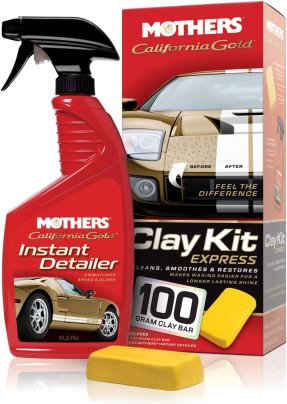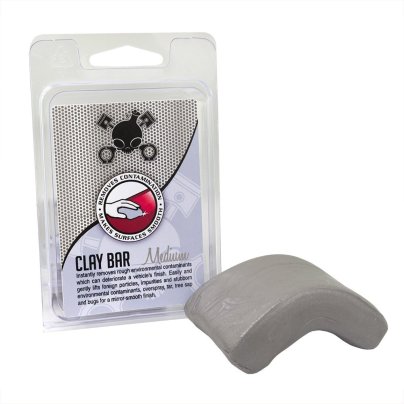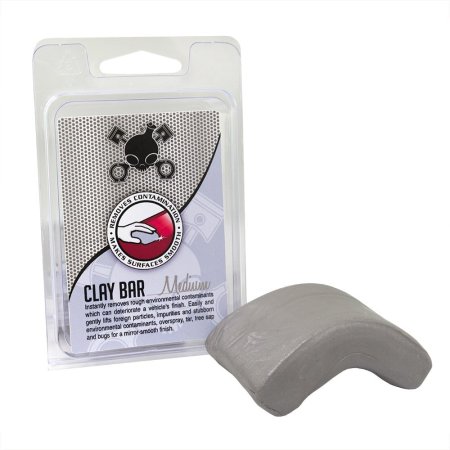We may earn revenue from the products available on this page and participate in affiliate programs. Learn more ›

No matter how many times you’ve washed your ride, there’s always bits left behind. Those bits can be things like tiny particles of dirt, pieces of dead bugs, or bits of bird droppings that you can barely see but can feel when you run your hand down a fender. Soap and water will never get them off, and waxing just covers them.
To remove those annoying pieces of detritus, you need a clay bar. A clay bar on your paint is like a pumice stone on tired feet or a detoxifying face mask. It removes the bad stuff and leaves you with a surface that’s fresh and smooth. This is how you find the best clay bar for you and your paint. In this article, we’ll round up some of the best clay bars on the market to help you find the one that fits your exact needs.
Summary List
- Best Overall: Mothers California Gold Clay Kit Express
- Best Value: Chemical Guys Medium Clay Bar
- Premium Pick: Griot’s Garage Paint Cleaning Clay
- Best for Severe Jobs: Meguiar’s C2100 Detailing Clay
- Easiest to Use: Mothers Speed Clay 2.0
How We Selected the Products
To choose the best clay bars, we looked at brands that are known for providing the best detailing products. Your paint is the most noticeable part of your vehicle and probably the most expensive to fix, so tried and tested products are important. We avoided products from unknown companies for the same reasons. Price is important and so is usability, or how well the clay sticks together when you use it without sticking to the paint. A reusable container is also important because you’re not likely to use the whole product at once and you don’t want to just stick it in a grocery bag every time.
Our product selections, rankings, and awards for this story are based on research. While we haven’t conducted real-world testing on all of these products yet, we’ve looked at consumer testimonials and data, tutorials, and general discussions on social media and in forums. We also consider price and specification in the context of the segment. And, of course, we rely on our institutional knowledge of the automotive landscape to weed out weak products.
Best Clay Bars: Reviews & Recommendations
Best Overall
Mothers California Gold Clay Kit Express
Best Value
Chemical Guys Medium Clay Bar
Premium Pick
Griot’s Garage Paint Cleaning Clay
Best for Severe Jobs
Meguiar’s C2100 Detailing Clay
Easiest To Use
Mothers Speed Clay 2.0
Our Verdict
Mothers California Gold Clay Kit Express won our pick for best clay bar overall based on its price, the fact that it comes with almost everything a DIYer needs, and because the coarseness of the clay is a great balance of effectiveness and beginner friendliness. Now get out there and make your paint hood smooth.
Types of Clay Bars
There are big differences between the different types of clay bars. Natural and synthetic, different grades of coarseness, and even different uses. We’ve summarized some of the key things you should look for and the things you should know.
Compound Strength
There are three main types of clay bars: fine, medium, and aggressive. Fine clay bars are perfect for vehicles with less contamination or for users who want to clean their finish but not spend all day doing it. They’ll remove much of the contamination but not all. They’re easier to slide across your paint and less likely to leave scratches. Medium bars bridge the middle ground, removing more stubborn contamination while still being OK for the average user. Aggressive clays will remove the most stubborn paint contamination. However, they’ll take more elbow grease to do it, and you’ll almost certainly need to machine polish your paint after you finish with the clay.
Glass Cleaning
A clay bar is a great way to clean your car’s windshield, too. A mild bar can remove stubborn debris that makes your windshield rough, hurts your visibility when the sun is low, and causes your wipers to leave water behind. It won’t get rid of pitting, but it can make a big difference. While most bars are glass-safe, check to make sure on the bar you’re planning to use.
Rubber Polymer/Synthetic
Rubber and synthetic clays like Mothers Speed Clay 2.0 are more like a sponge with a handle. They have two very different layers, one for the paint and one to hold on to. They’re not actually clay, but the handheld layer and the properties of the rubber “clay” layer make them much easier to use. Easier to hold, they also don’t require that you fold in contaminants and re-shape the bar with each panel of your vehicle.
Key Features
Strength
Knowing your goals and how much work you’re ready to put in are the key to picking strength. If you haven’t spotted any serious contaminants, or you’re just looking to remove a build-up of bug guts and road tar, then a fine clay is all you need. Trying to turn your car into a concours winner and are already planning to machine polish and correct the finish? Then the aggressive clays are going to help you get there.
Size
How much clay you’ll need depends on the size of your vehicle, how dirty it is, and how aggressively you’re planning to rub. Most clay comes in a 100-gram bar. With a mild clay, that should cover a couple vehicles. With a more aggressive clay or a more contaminated vehicle, you’ll probably need more. In that case, a 200-gram bar or a product that gives you multiple 100-gram bars in one container is probably a better bet. If you only need 100 grams, don’t buy a larger size. The clay can dry out over time.
Lubricant
Clay bars must be used with a lubricant, either one designed specifically for the purpose or a spray detailer or spray-wax product. If you don’t use one, the clay can stick to the paint and damage it. The most important thing here is that it makes the surface slick for the bar to slide across, so if you already have a favorite product on the shelf it should be fine to use.
Tips
- Break your clay bar in two (or more) pieces if you’re worried about dropping it. Smaller pieces may even be easier for you to hold as you work, and having an extra piece on hand may help to ease the stress of clay barring. You can also buy two clay bars instead of one, if you prefer.
- It’s nearly impossible to re-package your clay bar in the original packing after its first use. Properly store your clay bar for next time by putting it in a plastic bag or sealed jar. Spray some lubricant in the container/bag as well for added moisture.
- To prep your vehicle for clay barring, first wash it as you normally would. Rinse the vehicle down well and then wash it thoroughly. Prepare your clay bar and lubricant and clay bar the car. Then, rinse your vehicle and wash it again. That should remove any leftover clay bits and any suspended contaminants still on the paint.
FAQs
The easiest way to try out clay barring is to pick a trim piece closer to the ground that is less visible or to use or to try it out on a painted piece you don’t care about. A visit to the local junkyard may give you a low-cost panel to work on. Spray both the painted piece and clay bar liberally with lubricant. Begin with light pressure and measured movements.
Pick a spot on the paint that you want to remove, making sure it is a contaminant and not a scratch or paint chip. After spraying the clay bar and a small area around this spot, move the clay bar across the clean surface of the spot, making a few passes. Lift the clay bar, fold it over, and make another pass. If it glides more smoothly than the first pass, it is removing contaminants.
Fresh clay bars, straight from the package, should not scratch your paint. However, if you end up picking up sharp debris, it can scratch your paint. Watch the path of your clay bar as you move across the paint. Pause every so often to inspect the clay bar itself and knead it, folding in to get a fresh surface. Dig out any contaminants you can see and discard. If you drop the bar on the ground, it’s time to toss it.
The short answer is probably not. Depending on the application and age of the touch-up paint, the clay bar could end up removing it, leaving you with the original paint chip. If you happen to move across the touch-up paint as you go, you likely won’t cause any damage, but note these spots as you go in order to avoid them.








